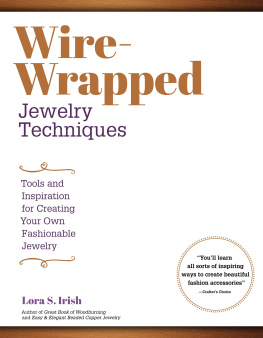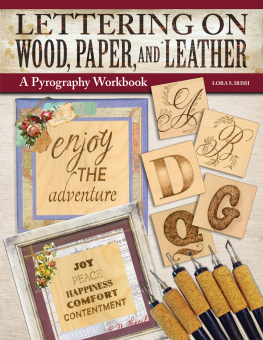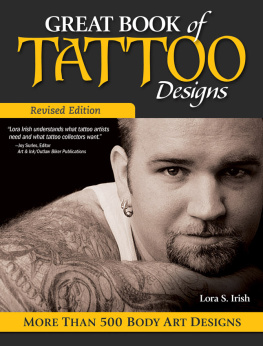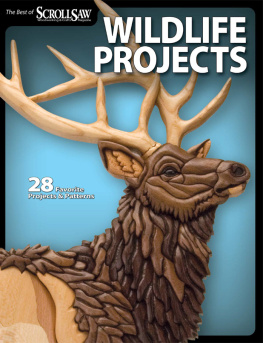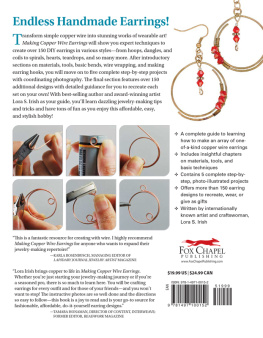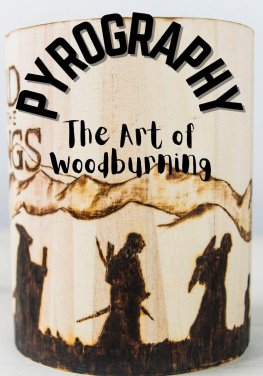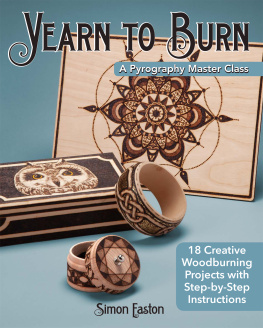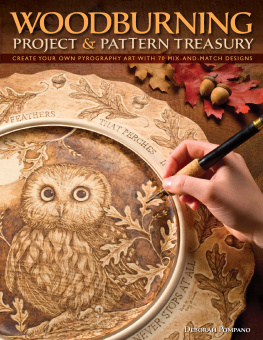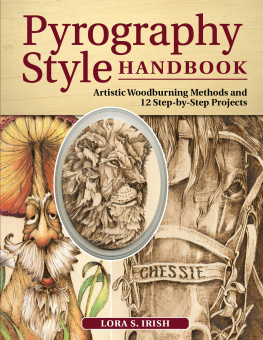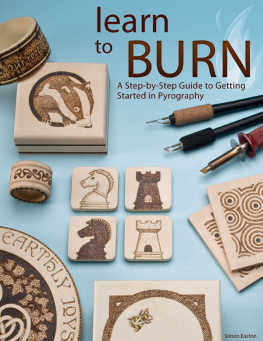LANDSCAPE
PYROGRAPHY
TECHNIQUES & PROJECTS
A Beginners Guide to Burning by Layer for Beautiful Results
LORA S. IRISH

ACKNOWLEDGMENTS
I wish to extend my deepest thanks to Chris Reggio, Colleen Dorsey, and Wendy Reynolds for their excellent work in the creation, development, and refinement of this manuscript. As an author, it is a wonderful experience to be working with such a well-skilled team.

2018 by Lora S. Irish and Fox Chapel Publishing Company, Inc., 903 Square Street, Mount Joy, PA 17552.
Landscape Pyrography Techniques & Projects is an original work, first published in 2018 by Fox Chapel Publishing Company, Inc. The patterns contained herein are copyrighted by the author. Readers may make copies of these patterns for personal use. The patterns themselves, however, are not to be duplicated for resale or distribution under any circumstances. Any such copying is a violation of copyright law.
ISBN 978-1-56523-931-9
The Cataloging-in-Publication Data is on file with the Library of Congress.
To learn more about the other great books from Fox Chapel Publishing, or to find a retailer near you, call toll-free 800-457-9112 or visit us at www.FoxChapelPublishing.com.
We are always looking for talented authors. To submit an idea, please send a brief inquiry to .
Printed in Singapore
First printing
Because working with woodburning tools and other materials inherently includes the risk of injury and damage, this book cannot guarantee that creating the projects in this book is safe for everyone. For this reason, this book is sold without warranties or guarantees of any kind, expressed or implied, and the publisher and the author disclaim any liability for any injuries, losses, or damages caused in any way by the content of this book or the readers use of the tools needed to complete the projects presented here. The publisher and the author urge all readers to thoroughly review each project and to understand the use of all tools before beginning any project.

INTRODUCTION
Pyrography is the art of creating simple line designs, highly detailed renderings, and finely shaded and shadowed drawings using a hot-tipped pen. As the electrically heated pen is pulled across the surface of the chosen medium, the tip literally burns the medium to create varying tonal value lines. The most common and familiar medium used in pyrography is wood, which is where the oft-used term woodburning comes from, although pyrography is done on many other media as well, such as paper, leather, and gourds.
The pattern of lines and shading strokes that you use in your pyrography work determines the art style of the finished piece. Any pattern can be worked in any art style or in a combination of styles. In this book, you will encounter many different styles of burning and be able to try small practice patterns for each style so you can discover which styles you prefer. Youll learn about pen tips, temperature settings, fill patterns, and everything else you need to know to set yourself up for success.
Everything you learn will enable you to burn interesting, textured, lifelike landscapes with your pyrography tools and chosen media. Youll be amazed at the variety and realism of what you can create. So without further ado, dive in and start burning!
CONTENTS

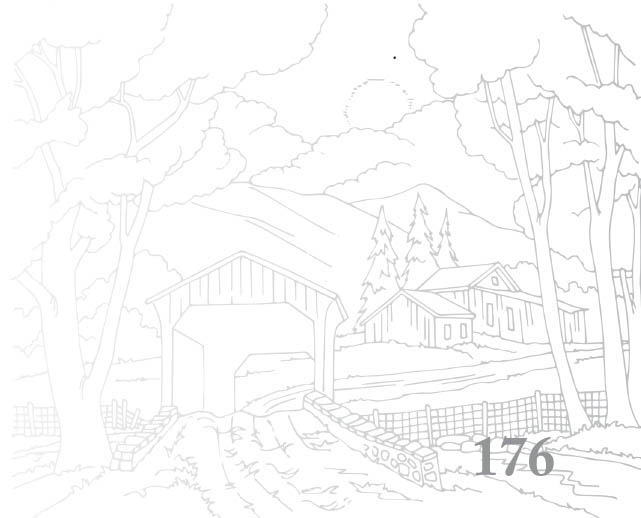

CHAPTER
| Basic Supplies and Techniques |
A pyrography project is created using four basic elements: the burning unit, the pen tips, the medium on which you are working, and the pattern or design you will burn. There is also a host of important basic techniques, finishes, and tricks that youll want to know to maximize your skills and ensure your finished piece turns out just how you want it. Well cover pen tips in detail in a later chapter, but for now, its time to learn about all the basic supplies and techniques, starting with burning units.
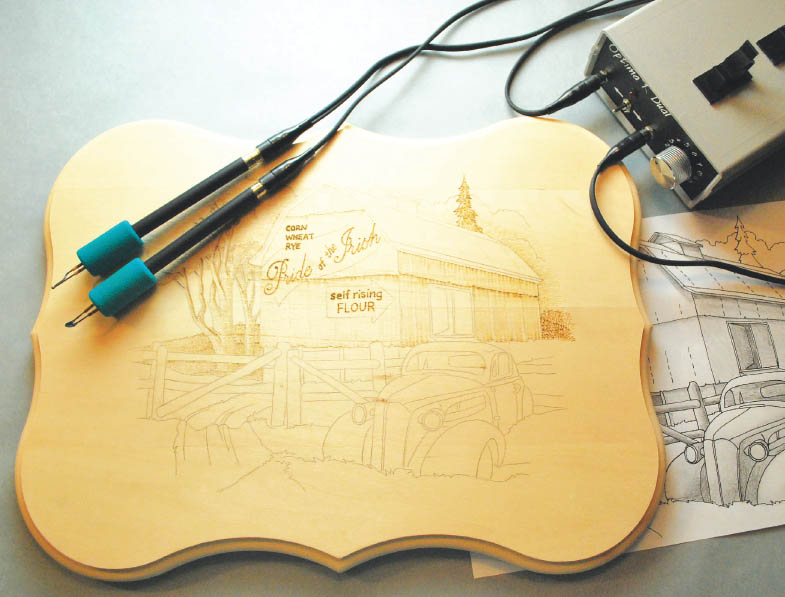
Burning Units
There are three styles of burning units: one-temperature tools, rheostat-controlled tools, and variable-temperature tools. Which one you choose depends on both the depth of your interest in the craft and your budget.
ONE-TEMPERATURE UNITS
One-temperature burning units are very similar to soldering irons. The solid interchangeable tips are made from brass and screw into the front end of the burning unit. When this tool is plugged into the wall outlet, it heats to a single temperature: high. The most commonly used solid brass tip is called a universal tip. This is the tip shown on the burning unit below, and can be used for both fine line work and shading work. The other common solid tips that are available for this type of burning unit are the calligraphy tip, used for lettering, and the flow tip, used for large area shading.
A full range of tonal values can be burned using a one-temperature tool. Burn pale tones as the tool tip begins to heat; save the darkest tones for when the tool tip has reached its full heat capacity.
RHEOSTAT TOOLS
A rheostat burning unit has a rheostat on the power cord that allows you to fully control the temperature of the pen tip. A rheostat burning unit uses the same interchangeable brass tips as a one-temperature tool. The tonal values that you can see in the practice board below are worked by controlling the pressure of the tip on the wood, the speed of the stroke, and the density of the lines burned, and by adjusting the rheostat temperature setting.
The color tones that you burn using this type of burning unit are controlled by the texture pattern and speed at which you burn. Moving the tool slowly will create a black/brown line. If you speed up your movement, the line color will become paler.
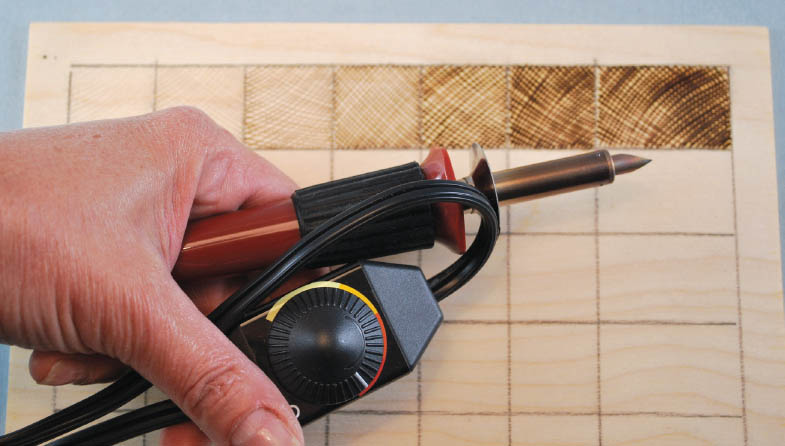
Here you can see an inexpensive beginners pen, along with its attached rheostat for regulating the temperature.
VARIABLE-TEMPERATURE UNITS
Variable-temperature units have a thermostat base that can be set in a wide temperature range, from very cool at setting number 1 to extremely hot at setting number 10. Because this type of unit has such a wide range of temperatures, you will need to discover which settings are best for your projects. You can accurately set the tip temperature to easily reproduce consistent tonal values in your work. This high level of control ensures that the pen tip remains at a constant temperature as you work.
Next page

